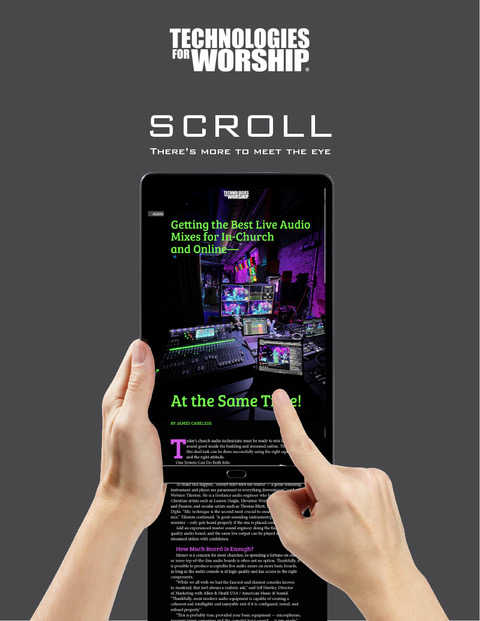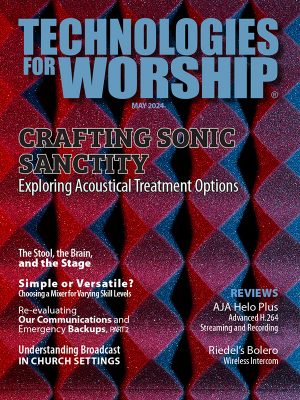by Andres Caamano
It’s been over two years since livestreaming worship services for numerous churches went from a luxury to an innate need.
Over this time, churches have learned plenty, in discovering the value toward improving their stream, aiming to grow their audience.
When numerous churches were unexpectedly thrust into streaming two-plus years ago, viewers were often forgiving when watching, to a point. Today, as many have returned to in-person services, the need to stream, though, clearly isn’t going away. In addition, the expectations of those viewers regarding the quality of the stream has also largely risen.
For churches that exclusively spent time on in-person services before the pandemic, adding streaming to its workload has been challenging.
In streaming the church’s worship services, though, it serves as an introduction to those who are considering attending the church. It also allows those seeking to stay connected, if unable to attend because of health reasons or advanced age. Over the past two-years plus, many church leaders have learned how crucial it is for their congregation as a whole.
While some churches initially used iPhones to capture their services, enough time has passed for any church to reach higher. Working toward growing an audience necessitates a stream comprised of quality audio as a starting point. Without reliable audio, a stream consisting of quality video and lighting is likely to be abandoned quickly by most viewers.
At this point, churches should have a solid understanding of what is achievable, thanks to goals having been laid out. With goals in place, it will also help keep the amount budgeted for streaming from spiraling out of control.
With a long-term vision also in place, it shouldn’t preclude regular discussion on what adjustments might be necessary toward improvement.
Learning from Forced Experience
Shortly after March 2020, for many congregants wanting to stay connected, having any worship service livestreamed was gladly consumed.
Advance to today, though, after months of having watched various levels of livestreams of services, and those expectations have risen.
“The basics of a good livestream are the video and audio quality,” noted Tim Dougherty, director of sales engineering for Wowza Media Systems. “We want to have a good volume to hear the content and have a good video image.”
For churches thrust into doing streaming in early 2020, too often it was a feeling of “Oh boy, it’s time to do something,” said Adrian Gates, former operations director at Crossroads Community Church in Fitchburg, Massachusetts. At first, “there’s an immediate interest to have an iPad. After a few years, it’s time to make sure the audio is good and the lighting is good.”
Among the features that churches have progressively added to their stream, Dougherty noted, included interactivity, such as monitoring chat. “Making sure there’s a person available while the stream is on” is crucial, Dougherty said. By doing so, it allows one to respond to “the felt needs that arise during a service.”
With so many congregation members largely having returned in-person, the knee jerk reaction might be considering to stop streaming.
That would be very shortsighted on the part of the church.
“Now that ‘everyone’ is back in person, not everyone is back in person,” explained Luke Ward, tech coordinator for Rodef Shalom Congregation in Pittsburgh. When asking, “‘Do we still need to be doing this?’, the answer is yes. It’s important for people to stay connected, those out of town, and those who will be staying at home.”
Lessons About Content Discovered While Streaming
For churches tasked to master streaming on the fly, among the frustrating lessons learned has been associated with copyright accountability.
In seeking ways to stream inexpensively to their congregations in 2020, hosting on YouTube and Facebook often were chosen. As churches streamed services, some content featured copyrighted material churches didn’t have rights to.
From there, the result often became an issue for the church.
“We discovered with YouTube and Facebook, that they are serious about copyrighted content,” noted Dougherty. “Because of music and movie clips, we’ve seen services foiled, if they run a 30-second clip from Saving Private Ryan. With artificial intelligence, their service gets shut down.”
While churches might voice frustration upon seeing their services shut down, Dougherty cautioned, “Just because you’re a church, doesn’t mean you can play all the unlicensed content you want.” Over time, he said he has seen churches improve on this front. “There’s a little more maturity when it comes to streaming, learning to play by the rules.”
Planning long-term for streaming has also become more common.
“Churches have learned that they need to budget for future equipment upgrades,” explained Ward. For too many churches, he added, “they found they had their pants at their ankles. That was because they had no equipment, or it was outdated.”
By budgeting for future equipment needs, Ward detailed, “even when putting aside $5,000 a year, in a couple years, they’d have funds for a quality camera. And it won’t feel like a sting if something breaks.”
Savings can sometimes be found on more than just hardware. “I recently helped a local church, that was paying about $3,000 for streaming,” explained Ryan Brenneman, senior product specialist for Mobile Video Devices. “A number of services we were able to cancel, and replaced it with a system used by volunteers.”
Where to Focus to Achieve Quality Streaming
When deciding on what to plan for when budgeting, it’s best to not focus on what larger churches are doing.
The focus should instead be “on creating the best livestream within their budget,” noted Brenneman. “They should not be focused on keeping up with the Joneses. God has given us the gift of creativity. (At smaller churches), I’ve seen better productions using cellphones, compared to churches spending $10,000 to $15,000 for a camera.”
While megachurches receive plenty of attention for their high-quality streamed services, most churches are smaller in size and budget. Aiming to be a wise steward of budgeted dollars is a solid path to greater success.
“If you’re the type comparing your stream to those with the highest budgets, you’ll tend to be disappointed,” said Gates. “Churches like Elevation have elements just for the online audience and have the budget to do it. Instead, compare yourself more to a church similar in size and in your region.”
Nonetheless, some smaller churches have taken a page from megachurches when streaming.
“Philosophically, the megachurches lead in style for music, speaking style, and choreography,” noted Dougherty.
With megachurches setting the bar, how some churches opt to create content is notable; not necessarily in a good way.
“In some ways it’s been good. In other ways, it’s not. Don’t act as if you are Rick Warren or Saddleback (if you’re a small church),” said Dougherty. “Be who you are … but many have been effective at (acting as a larger church for streaming).”
How to Best Aim to Achieve A Quality Stream
When deciding how best to arrive at a quality livestream of your service, there are numerous potential paths.
Narrowing down where to begin, whether it be audio, video or lighting can a major hurdle in of itself.
Between Dougherty, Brenneman, Gates and Ward, though, each agreed that the first place to improve should be audio.
“The biggest section is audio. People will forgive nonoptimal video to a point, if the audio is a good experience,” Brenneman detailed. “If the mix is being mixed in the same room, get a separate space to produce it.”
Gates, currently a media consultant, agreed to the value of audio as the building block for a streamed service. “If you have good audio, they will listen to it like a podcast,” he said. “Even if the cameras are poorly positioned, or the lighting is too dim, they can still listen to it as if it were a podcast.”
For Dougherty, too often audio issues present themselves all too significantly during a streamed service.
“Too often, you can’t hear the music properly, or the speaking properly,” explained Dougherty. To boost the streaming experience, he noted, “mixing discreetly for the video simultaneously to an acoustical mix, you’ll enhance the stream incredibly.”
Describing how it would help, “If you’re in a church building, they’re not going to mic the drums. They then can’t hear it online,” Dougherty said. “Therefore, you will need a dual mix, and you will need to turn up the bass and the drums.”
In terms of order of importance, “the first system to update would be the audio system, no doubt,” Ward explained. “Good video is useless without good audio. And if you’re not going to have good lighting, there’s no point to turning on the cameras.”
What Piece of Equipment Can Best Improve Your Stream?
In seeking that ideal piece of equipment to significantly improve your streaming capabilities, Ward pointed to a video switcher.
“I can’t believe this is even possible, with the Blackmagic Design ATEM Mini video switcher,” he noted. “It’s a full-functioning video switcher for $300. With the Mini and Mini Pro, you can manage all your audio channels separately, and stream a clean broadcast directly from the switcher.”
With features such as built-in effects, like fades and transitions, the software mimics a full-size software panel. The functionality of the Blackmagic Mini line “does everything a $3,000 to $4,000 switcher does, for $300,” he added.
With the advancements in software-based switching, Brenneman cited a few items that have been “game changing for churches.”
How churches often tend to implement streaming is as a “crawl, walk, run approach,” Brenneman said. Some current tools have churches “starting to bring in video sources over IP such as NDI and audio over Dante.” He also highlighted certain video switchers, with “some churches choosing to use small video switchers from Roland or Blackmagic Design. To push a stream live, one can do it with one button, or record, which many volunteers find very useful.”
Outside of a switcher, Dougherty cited that a video encoder as the crucial piece to a quality livestreaming system.
“The encoder without question (is the most important piece),” said Dougherty. “The encoder creates the ability for the packager to do its job. You need to send the best thing to YouTube, Wowza, Twitch, where the encoder and network is critical.”
Andres Caamano is a writer and editor with nearly 20 years’ experience, including over four years bringing attention to the latest news in audio, video, and lighting technology for houses of worship.





